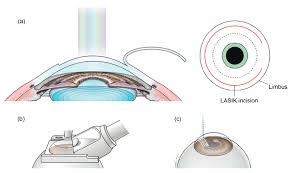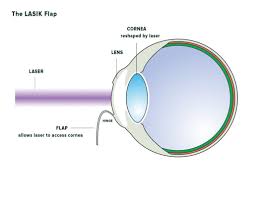Table of Contents
ToggleYes, you can participate in MMA after LASIK, but timing and precautions are crucial. With proper healing and care, you can safely return to the sport and enjoy the benefits of improved vision without glasses or contact lenses.
Mixed Martial Arts (MMA) is a physically intense sport that demands peak performance and strength. Athletes rely on precision, clarity, and quick decision-making, all of which are enhanced with sharp, unobstructed vision. LASIK surgery, a popular procedure to correct vision, eliminates the need for glasses or contact lenses.
But a question arises for those involved in contact-heavy combat sports like MMA—when is it safe to return, and are there risks involved? This blog will guide you through the answers.
Understanding LASIK and Its Impact
LASIK, or Laser-Assisted in Situ Keratomileusis, is an advanced, minimally invasive vision correction surgery. It reshapes the cornea to correct refractive errors like nearsightedness, farsightedness, and astigmatism. Although LASIK has an impressive safety record, it still involves a brief recovery period and temporary vulnerabilities, especially for athletes engaging in high-contact sports.
The corneal flap created during the procedure requires healing time to securely reattach. While LASIK offers profound improvements in vision, the eye must be protected during this initial recovery phase.
LASIK Success in Athletes
LASIK surgery has helped athletes across various sports achieve optimal performance and convenience by eliminating reliance on visual aids like glasses or contacts, which can be limiting during intense physical activities. But in the world of MMA, where strikes, grapples, and physical contact are unavoidable, special attention needs to be paid to recovery.
Why the Timing Matters
Resuming MMA training or competing immediately after LASIK surgery is not recommended. The primary concern is the healing corneal flap, which remains fragile during the first few weeks after surgery.
If struck or rubbed too hard, there’s a risk of dislodging the corneal flap. Even though the chances of this occurring are low with modern LASIK techniques, returning too soon could lead to complications like infection, slower healing, or even vision regression. To promote a successful recovery, it’s crucial to follow your surgeon’s post-operative guidelines.
Typical Recovery Timeline for LASIK
Here’s a general timeline for LASIK recovery:
- First 24-48 hours: Most patients experience clear vision immediately or within a day post-surgery. During this time, focus on resting and avoiding strenuous activities.
- First week: Avoid any direct contact with the eyes, including rubbing or pressure. Regular use of prescribed eye drops will prevent dryness and infection.
- 2 weeks onwards: Low-impact physical activities can typically be resumed, such as jogging or weightlifting. Combat sports, however, are still restricted.
- 1-2 months: By this stage, most corneal healing should be completed. Athletes can typically return to MMA training, but it’s critical to confirm with your surgeon.
Individual healing rates vary, so always consult your ophthalmologist for personalised advice.
Precautions for Returning to MMA After LASIK
Returning to MMA after LASIK requires careful consideration of eye protection, gradual reintroduction, and monitoring for any discomfort or visual changes. Follow these safety precautions to ensure a smooth transition:
1. Give Your Eyes Time to Heal
Respect the surgeon-recommended recovery timeline, even if your eyes feel normal sooner. It’s important to remember that surface healing may appear complete, but deeper healing of the corneal tissue can take weeks.
2. Avoid Sparring Early On
During early recovery, limit your training to non-contact activities like conditioning, footwork drills, and technique practice. Avoid sparring or any situation where your eyes risk being struck.
3. Use Protective Gear
Once permitted by your surgeon to return to sparring, consider wearing eye-protective gear for added safety. While this may not be standard for all MMA athletes, using specialised goggles during the initial phase of reintegration can minimise the risk of corneal impact.
4. Monitor Vision for Any Changes
Pay attention to how your vision adjusts during training sessions. If you notice blurriness, discomfort, or persistent dryness, take a step back and consult your surgeon.
5. Commit to Post-Surgery Protections
Even when you’re back to full-contact training, continue to carry out proper eye care:
- Rest your eyes adequately after long training sessions.
- Avoid excessive exposure to sweat or contaminants that might cause infection.
- Use lubricating eye drops if dryness persists.
Benefits of LASIK for MMA Athletes
LASIK surgery can significantly enhance your performance as an MMA athlete. Here are some key advantages it offers:
1. Improved Vision Clarity
Better vision improves reaction times, situational awareness, and coordination during combat. You’ll be able to see your opponent’s moves more clearly and react faster to strikes or takedowns.
2. No More Contact Lenses or Glasses
Contact lenses can shift or dry out during intense exercise, while glasses are not suitable for combat sports. LASIK eliminates these challenges, giving you the freedom to compete without restrictions.
3. Enhanced Confidence
Knowing that your vision won’t be hindered by fogged-up lenses or misplaced contacts allows you to focus entirely on your performance.
4. Cost-Effective Over Time
Though LASIK has an upfront cost, it eliminates ongoing expenses of glasses, contact lenses, and maintenance products, making it a practical long-term investment for dedicated athletes.
Risks to Consider
While LASIK offers countless benefits, it’s important for MMA athletes to consider the potential risks involved:
1. Corneal Flap Injury
This is the single most critical risk. During early recovery, a direct blow to the eye could dislodge the flap. Over time, however, the risk significantly reduces as the flap firmly reattaches.
2. Dry Eye Syndrome
Dryness is a common side effect after LASIK, especially during the initial recovery weeks. While it typically resolves over time, extended screen time or intense sparring sessions could exacerbate symptoms. Ensure proper hydration and apply lubricating eye drops as necessary.
3. Potential Regression
Although rare, there’s a possibility of slight vision regression over time due to natural ageing or trauma, including repeated blows sustained in MMA training.
When to Consult Your Surgeon
It’s essential to maintain open communication with your eye surgeon when resuming high-contact sports like MMA. Schedule follow-up appointments to assess healing progress and ask specific questions such as:
- “When can I safely return to full-contact training?”
- “What protective measures can I use during sparring?”
- “Are there long-term risks I should monitor as an MMA athlete?”
Your surgeon’s insights will provide clarity and confidence as you ease back into your sport.
Final Verdict
LASIK can be a game-changer for MMA athletes, offering the freedom of clear vision without the hassles of glasses or contact lenses. However, discipline and patience during the recovery period are absolutely essential. Take the time to heal, consult your surgeon regularly, and follow safety guidelines before returning to the octagon or ring.
Improved vision can elevate your MMA performance, but safeguarding your eyes will keep you in the sport for the long haul.
Are you considering LASIK to enhance your life and performance? Speak to experienced surgeons and learn more about the benefits tailored to athletes like you. Your path to sharper vision—and stronger performance—starts here!













